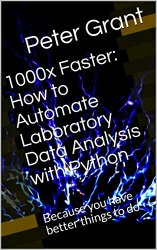1000x Faster: How to Automate Laboratory Data Analysis with Python: Because you have better things to do
- Добавил: TRex
- Дата: 30-06-2021, 06:03
- Комментариев: 0
 Название: 1000x Faster: How to Automate Laboratory Data Analysis with Python: Because you have better things to do
Название: 1000x Faster: How to Automate Laboratory Data Analysis with Python: Because you have better things to doАвтор: Peter Grant
Издательство: Peter Grant
Год: 2020
Формат: ePUB
Страниц: 136
Размер: 10 Mb
Язык: English
Scientists and engineers are inventive, curious people. We spend our days answering questions about the universe, and creating inventions that make day to day life better. In order to do so we need to analyze data. A lot of data. And since our projects often involve hundreds of experiments with little variation from one test to the next, this can result in hours upon hours of our time spent sifting through nearly identical spreadsheets. If we could speed up that process we could answer more questions, create more inventions, and provide more value to society while feeling more fulfilled in our careers.
Enter 1000x Faster. This book is based on the premise that anything which is highly repeatable and routine can be performed automatically by computers. And since so many of our data sets involve very little variation from one test to the next, that means we can write computer programs to perform the data analysis for us. Instead of spending weeks analyzing mountains of data, we can spend a few days writing a testing a script that can perform all of the analysis in minutes. Which frees up our time to get back to asking questions, communicating results, and seeking funding for the next big project.
This book will teach you how to write Python scripts that automatically analyze laboratory test data for you. It will teach you the specialized concepts through the example of analyzing a counterflow water to water heat exchanger. It will also provide a detailed example, including Python code that you can copy/paste into your editor to follow along, of how you can use these techniques to solve a real engineering challenge. It will teach you how to structure your laboratory tests to allow automation, how to identify the conditions of each test, how to perform the analysis of each test, how to plot the data as the tests are being analyzed, how to store the data in a user-friendly manner, how to (Both manually and automatically) check the lab data set and calculations for errors, and how to generate regressions that let you explore and understand the data set. Once you finish reading the book and following the examples you'll be able to write scripts automating your data analysis in all of your projects.
Внимание
Уважаемый посетитель, Вы зашли на сайт как незарегистрированный пользователь.
Мы рекомендуем Вам зарегистрироваться либо войти на сайт под своим именем.
Уважаемый посетитель, Вы зашли на сайт как незарегистрированный пользователь.
Мы рекомендуем Вам зарегистрироваться либо войти на сайт под своим именем.
Информация
Посетители, находящиеся в группе Гости, не могут оставлять комментарии к данной публикации.
Посетители, находящиеся в группе Гости, не могут оставлять комментарии к данной публикации.
